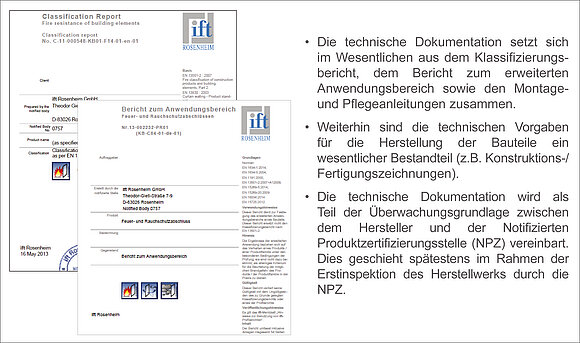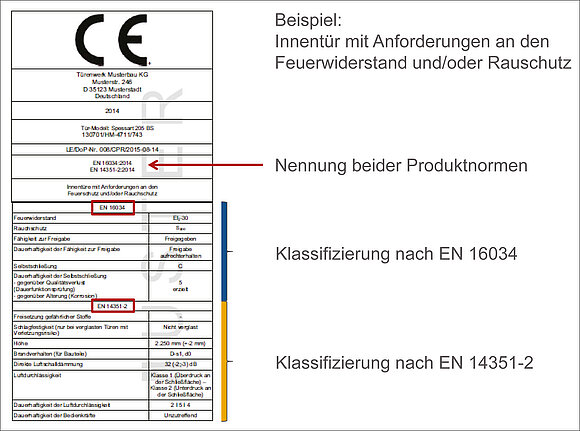Reading time: 1 minute
The product standard for doors, gates and windows with fire protection and / or smoke control properties, DIN EN 16034 is raring to go: It will control many new things both for system providers and also for manufacturers and will become noticeable in day-to-day life.
With the introduction of the product standard, preparation of a declaration of performance and the CE marking will first now be possible even for fire-resistant doorsets and then become mandatory. The system provider and manufacturer will have to say goodbye to the system so far of approvals issued by supervisory construction authorities.
There will also be changes on the part of the institute and approval bodies. A new body is appearing on the horizon with far-reaching duties – the Notified Product Certification Body (Notifizierte Produktzertifizierungsstelle, NPZ). The activities of this body stretch from test specimen planning to testing and preparation of the verifications right up to surveillance and certification of the manufacturers. The testing of the fire-resistant doorsets itself is done by a testing body that need not be the same as the NPZ. However, the NPZ retains the responsibility for the entire procedure. The areas of surveillance / certification and labelling of fire-resistant doorsets are described in detail in the following.
Basic Principles
So-called surveillance bases will have to be created for the surveillance and certification of the manufacturers. This documentation describes the fire-resistant doorsets and they contain the specifications for their manufacture. This documentation forms the basis of the activity for the NPZ and the evaluation of the surveillance results. Essentially, the following documents form the basis of this surveillance:
- the classification report
- the EXAP report (extended area of application)
- system documentation for the manufacture of fire-resistant doors
The classification report
In this report, the fire-resistant doorsets are classified on the basis of tests conducted, the components tests are described and the system limits are specified. This represents the direct area of application. Substitution of components or deviations from the designs described, parameters of construction products are not possible or possible only within a narrow framework.
The EXAP report (extended field of application)
In this document, based on other verifications, expert opinions and / or assessments, clearance is issued for the use of alternative components, profiles or dimensions for the system of the fire-resistant doorsets. This represents the extended area of application.
System documentation
As always, this documentation also contains all information that is necessary to manufacture the fire-resistant doorsets (manufacturing drawings, tolerances etc.).

Certification and surveillance
The contract
At the beginning of the entire procedure, a surveillance and certification agreement is concluded between the manufacturer and the Notified Product Certification Body. The subject matter is defined as the surveillance and certification (= fire-resistant door system) in this agreement, and the costs of surveillance / certification are mutually agreed to and the "rules of the game" are laid down. No agreement can be concluded without a valid classification report.
Initial inspection
The Notified Product Certification Body conducts an audit at the manufacturer's factory. In the course of these audits, the basis for surveillance is mutually agreed with the manufacturer and the manufacture of the fire-resistant doors is monitored. This is why ongoing production is necessary at this point in time. Moreover, the factory production control (FPC) must be set up, whose contents and documentation is the subject matter of this visit. The FPC is identified as a significant task of the manufacturer in the product standard (Point 6.3). The purpose of the FPC is to ensure and document design and manufacturing conformity of the fire-resistant doorsets. This is why the FPC system cannot begin only in the production, but must already be in use during the design and planning phase in order to avoid errors or identify them at the beginning of the process.
Moreover, dealing with non-conforming products must be specified in this system and the classification / labelling of the fire-resistant doorsets must be specified. What must not be overlooked is that the qualification of the personnel, maintenance and service of machines and systems as well as the surveillance of test equipment must also be an integral part of the FPC system.
Certification
After the initial inspection, the NPZ evaluates the results of the audit and whether the basis for surveillance is complete and adequate in order to manufacture conformant fire-resistant doorsets. The manufacturer also has the option of eliminating non-conformances that have been identified by corrective measures. These measures must be proven to the NPZ with the help of suitable verifications.
If there is a favourable overall rating (= conformity rating) by the NPZ, the "Certificate for certifying the constancy of performance" is issued by the NPZ with a validity of three years for the manufacturer. From this point in time, the manufacturer may provide his fire-resistant doors with a declaration of performance and the CE mark and market them.
Continuous surveillance
After the certification, the continuous surveillance of the manufacturer begins. An audit is conducted in the manufacturing factory every year in accordance with the specifications from the product standard. In case of favourable results, the "Certificate for certifying the constancy of performance" is maintained or renewed after three years. Apart from auditing the production and the FPC, modifications in the manufacturing process or the advanced development of components or constructions in the basis of surveillance, are an important constituent of the surveillance.
Declaration of performance and CE marking
Declaration of performance
An example of the declaration of performance (DoP) is given in the product standard (Annex ZA, clause 2.2). You can get detailed information and a sample from the Construction Products Regulation (CPR). The contents of the DoP are binding for the manufacturer. In the DoP, all significant properties of the fire-resistant doorsets (= mandated properties, refer to the product standard Annex ZA.1, Table ZA.1) must be listed. Moreover, at least one property must be classified. Properties, for which the manufacturer does not provide any information, must be marked with "npd" (no performance declared).

CE Marking
With respect to the contents of the CE mark, the specifications are also given in the product standard (Annex ZA.3). The "npd" option should not be used here. Only those properties should be listed for which the manufacturer undertakes classification. The information of the target market required by building law must be specified as a minimum. Moreover, permanent and visible marking must be affixed on the fire-resistant doors. The letters "CE" according to the marking ordinance and the number of the NPZ must be specified (example for the NPZ ift: "CE – 0757“). A label must be affixed on the packaging of the fire-resistant door. This labelling must contain the following information:
- Manufacturer (name, contact information for the customers)
- Product type or designation
- Typecasting the product
classification of the fire resistance and / or smoke control classification and / or class of self-closure
The procedure of the declaration of performance and the CE marking in the market
The declaration of performance must be provided to the customer directly. It may be implemented as paper, in electronic form via email or on call e.g. on the website of the manufacturer. The CE mark must be affixed on the fire-resistant doorset or its packaging or it must be available in the documents accompanying the product. A link must be established between the respective DoP and the CE marking by a unique code or numbering that enables the customer to identify and assign both documents.
Conclusion
Experience with other product standards has shown that the implementation of the regulations and administrative requirements associated with it need time, but that it is feasible with systematic preparation for all those involved. Hence, it makes sense to deal with the product standard and the associated changes at this juncture and to initiate the planning for implementation. The ift Rosenheim is at your disposal as a notified and product certification body with experience and appropriate solutions. Thus, in the field of fire-resistant doorsets nothing must be "on fire" – not even after the introduction of DIN EN 16034.
Literature
- DIN EN 16034:2014-12
Pedestrian doorsets, industrial, commercial, garage doors and openable windows -Product standard, performance characteristics - Fire resisting and/or smoke control characteristics EN 16034:2014-12, Beuth Verlag GmbH, Berlin


